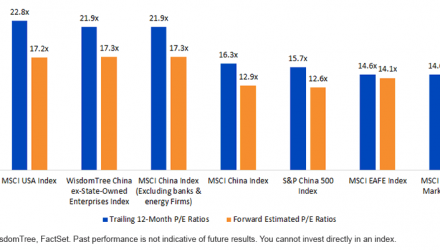By Bradley Krom, Associate Director of Research and Matt Wagner, Research Analyst
Higher earnings growth tends to coincide with valuation premiums, and Chinese equities are no exception. By nature of the country’s fast-paced economic growth and the rising market capitalization of the Information Technology sector, China is among the highest-growth markets in the world. This broad-based high-growth trend is evident in the more than 20% long-term earnings growth estimates of Chinese indexes, as well as in price-to-earnings (P/E) ratio premiums compared to broad emerging markets and developed international indexes. Below, we contrast WisdomTree’s favored methods for accessing China against MSCI’s approach to China and emerging and developed markets. In our view, global competition among businesses will also increasingly imply a global competition for capital.
Global Fundamentals Comparison
Looking at headline fundamentals, China is not necessarily cheap compared to slower-growing economies. China tends to trade at a premium to emerging markets, which tend to trade at a discount to developed markets given the fundamentally different risk profile. Today, the S&P China 500 Index is the least expensive way to gain broad-based exposure with a P/E ratio of 15.7x, a sizeable discount to the MSCI USA Index at 22.8x. On the other hand, the WisdomTree China ex-State-Owned Enterprises Index, currently at a P/E of 21.9x, is at comparable valuations to the U.S.


The key to understanding current valuations is rooted in growth rates and profitability: Growth expectations of 28.2% for the ex-State-Owned Enterprises Index are more than double the 13.2% for the U.S., and return on equity offers an improvement of more than 140 basis points. Over the last several years, Chinese firms have grown at remarkable rates. In response, investors are comfortable paying a market premium to gain access to that growth. In our view, this trend is primarily reflected in the PEG ratio of China-centric strategies, which are all below 0.8. This compares to the U.S. Index’s PEG ratio of 1.72x. As a rule of thumb, many investors focus on investing in strategies with PEG ratios below 1. While P/Es may appear stretched, as long as Chinese firms continue to meet lofty expectations quarter over quarter, the market rally in asset prices could continue.
Sector Tilts: Explaining Valuation Differentials in China
Looking deeper, varying sector tilts, alongside growth estimates, justify the valuation differentials across China indexes, in our view. The MSCI China Index and the S&P China 500 Index are broad indexes with nearly 30% weight in Financials and Energy companies, an over-weight of more than 10% to the ex-State-Owned Enterprises Index. The ex-SOE Index tilts away from these value sectors in favor of the growth-oriented Information Technology and Consumer Discretionary sectors. The chart below illustrates the impact of certain sector weights on P/E ratios. By removing banks and Energy stocks from the MSCI China Index, two lower-growth industries with a high degree of state ownership, the value-tilted MSCI China benchmark is at similar valuations to the ex-SOE Index.
Ex-SOE: Comparable Valuations to the U.S.

Comparison of P/E Ratio Valuation Statistics across Indexes (as of March 29, 2018):
A review of sector exposures helps inform the valuation differentials as well as clearly identify large sector bets. One of the biggest takeaways from the chart of sector weights shown below is that the MSCI China Index has an almost 65% combined weight in Financials and Information Technology. In our view, for a broad-based China index, these are extreme sector weights. The S&P China 500 Index provides a much more diversified approach across sectors, with no sector having more than a 25% weight. The sector allocations that emerge from the ex-State-Owned Enterprises Index also provide some interesting insights to consider. Three sectors stand out as under-weights:
- Telecommunication Services: Large firms like China Mobile dominate this sector, but these larger players are removed when the focus is on companies with less than 20% government ownership.
- Financials: When people think of Chinese Financials, the so-called “big four” come to mind—China Construction Bank, Bank of China, Industrial and Commercial Bank of China and Agricultural Bank of China. All of these firms are more than 20% owned by the government and are widely viewed as instruments of state policy.
- Energy: In this strategic sector, there is also a preponderance of large firms that are owned by China’s government, as it is focused on securing China’s energy future
Conclusion
We are bullish on the earnings growth potential across the region, but we caution investors to consider trade-offs of growth and broadness across Chinese indexes. Valuations relative to the size of the growth opportunity, particularly in the ex-SOE Index, do not seem stretched, in our view. For a deeper look, check out our full white paper on these indexes.
Important Risks Related to this Article
Investing in Chinese issuers involves special risks, including (but not limited to): currency devaluations and exchange rate fluctuations; intervention by the Chinese government (including risk of nationalization or expropriation); higher rates of inflation; greater political, economic and social uncertainty; market volatility; and lack of market liquidity. The Chinese financial sector is undergoing significant structural and regulatory changes, which have the potential to adversely affect the profitability of Chinese financial companies. The global deterioration of the credit markets since late 2007 generally has had an adverse impact on a wide range of U.S. and international financial institutions and markets. These domestic and global factors may make Chinese financial companies especially vulnerable to losses from rising interest rates, loan defaults, price competition, and credit and equity bubbles and crashes. Consequently, securities issued by Chinese financial companies may exhibit dramatic market price fluctuations.

